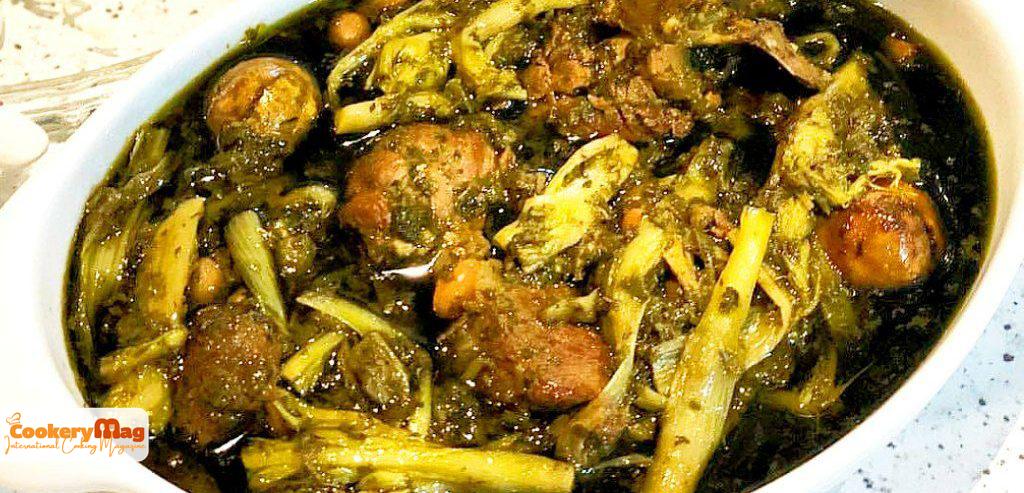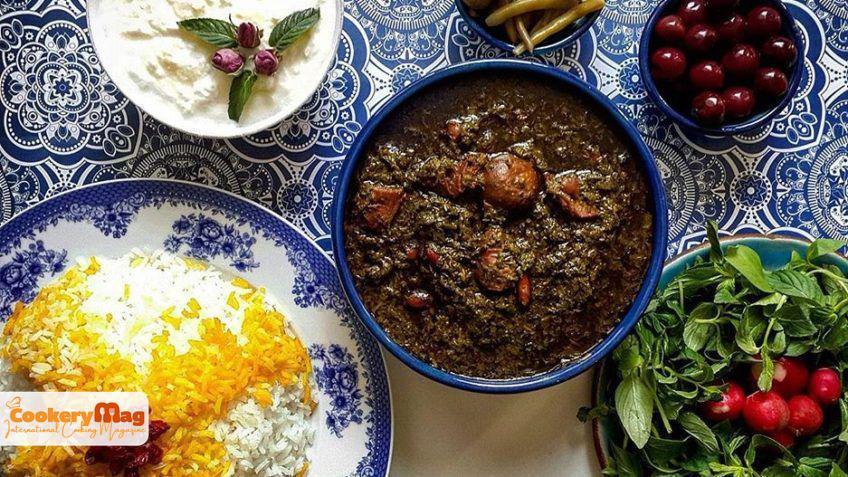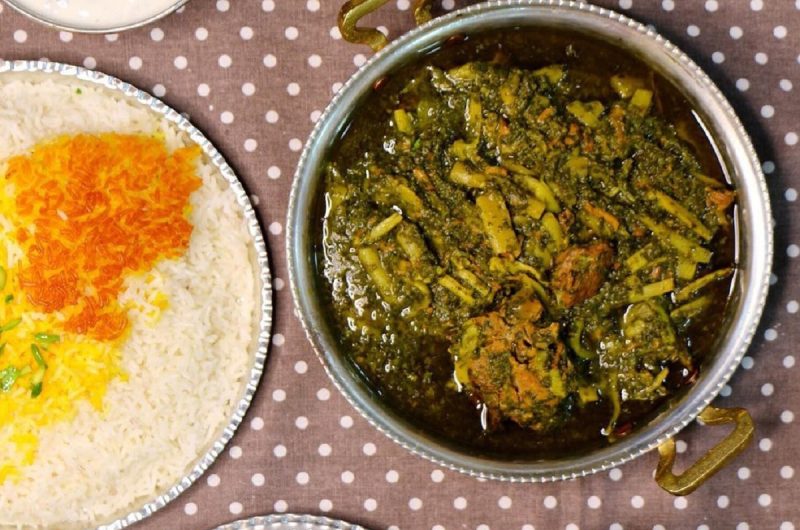© All Rights Reserved.
Khoresh Kangar Recipe | Delicious Persian Acanthus stew in 8 steps
Khoresh Kangar is one of the delicious Iranian dishes known as a seasonal stew because acanthus is harvested from late winter to early summer.
To see the complete and step-by-step tutorial on how to prepare Khoresh Kangar, stay tuned to Cookery Magazine‘s educational site.
Khoresh Kangar, in addition to having a very good taste and aroma, also has many benefits for the body due to the presence of artichoke.
Artichoke has many properties that you can benefit from these valuable properties by preparing this stew.
Among the most important properties of artichoke we can mention strengthening the heart, invigorating, appetizing, strengthening the digestive system, and helping to digest food easily.
Artichoke stew is usually cooked with red meat, but it can also be prepared with white meat, such as chicken and turkey.
In addition, you can prepare this delicious stew without meat and be completely vegetarian.
Ingredients for making Khoresh Kangar
| Mutton | 500 grams |
| Onion | 2 medium size |
| Tomato paste | 2 tablespoons |
| Split pea | 1 cup |
| Dried lime | 2 pcs |
| Artichoke | 350 grams |
| Mint | 50 grams |
| Parsley | 150 grams |
| Liquid oil | As much as needed |
| Boiling water | As much as needed |
| Salt and red/black pepper | As much as needed |
| Brewed saffron | As much as needed |
| Turmeric and powdered dried lime | As much as needed |
Recipe for making Khoresh Kangar
The first step
To prepare a delicious Acanthus stew, at the beginning of the work, we wash the split pea and put it in a suitable bowl. Next, add enough water to cover the split pea about a finger above the bowl and let it soak for 2 hours.
The second step
Now we make a few small holes in the dried lime with a fork and pour it into a bowl containing lukewarm water, then let it stay in the water for 1 hour until its bitterness disappears completely. After this time, peel the onion and wash it.
The third step
Now chop the onion into small pieces, then put a suitable pot on low heat and add some liquid oil to it. Next, add the onion to the pot and fry until the onion becomes light and glassy.
The fourth step
Next, cut the meat into equal cubes and add it to the pot. Now we roast the meat until it changes color, then add the tomato paste to the pot and continue roasting until the tomato paste is fried.
The fifth step
When the raw smell of tomato paste disappears, add some salt along with turmeric, red pepper, and dried lime powder to the pot and fry until they are fried. Now, we put the soaked split pea in a colander and rinse it.

The sixth step
Now add the split pea to the pot and fry it a little, then add the soaked dried lime to the pot. Next, add enough boiling water to cover the contents of the pot and close the pot’s lid.
The seventh step
Next, let the stew stay on the heat for 2 hours until the ingredients are fully cooked.
After 1 hour, we wash the artichokes and chop them into desired sizes, then finely chop the mint and parsley, then place a suitable pan on low heat and pour some oil into it; after the oil gets hot, put the artichokes with saffron, mint, and parsley into the pan and roast them.
The eighth step
Finally, we let the stew stay on the heat until it is completely cooked. When the stew has settled, we take the pot off the heat and taste it at the end of cooking.
If the sour taste is not enough, you can add some Verjuice or lemon juice to it.
After the stew is well-oiled and fully prepared, pour it into the desired dish and serve it with rice and Shirazi salad. Enjoy your meal.
Artichoke stew with chicken
Artichoke stew is usually cooked with mutton or veal meat, but if you cannot eat red meat, you can make this traditional and very useful stew with chicken.
You can use one-piece chicken such as chicken breast and thigh like chicken stew, But we recommend that in order for the stew to keep its original appearance and not look like a chicken stew, chop the chicken meat into minced meat and use it in the stew.
The cooking method of this stew is no different from red meat or chicken.
The advantage of cooking this stew with chicken over red meat is that because the chicken cooks faster, your stew is ready to serve sooner.
You can add 400 grams of chicken meat to the above recipe. Of course, because chicken meat is cheaper and has many properties for the body, we recommend that you use more in your stew than red meat.
Golden tips for having the best Khoresh Kangar
- If your taste is spicy, add some red pepper.
- Be lavish and generous in pouring saffron in this stew.
- When washing artichokes, be careful of their tiny blades.
- Many people use pomegranate paste instead of tomato paste.
- The later you add the artichoke to the stew, the firmer it remains.
- You can add a little Bitter orange paste to the Khoresh Kangar at the end.
- If you get a lot of artichokes, don’t pack them raw in plastic freezers; fry them a little, then pack them.
- The amount of water is limited. If you see that your meat is not fully cooked and needs more water, you can add some water to it.

- You can use lemon juice or verjuice instead of dried lemon. Be careful to add the seasoning at the end of 10 minutes to preserve the color of the Khoresh Kangar.
- To prepare Khoresh Kangar, you must have a mint parsley that is the size of a third of a third of a mint. This means that the amount of parsley should be 3 times that of mint.
- You can halve the amount of vegetables in the Persian Acanthus stew, and for the other half of the vegetables, you can use Ghormeh Sabzi vegetables, which are also based on your taste.
- This delicious stew is prepared in two ways, which is completely tasteful; some people prepare it with vegetables, in which case it is very similar to celery stew; Some other people prepare it with paste and split pea, which is very similar to Khoresh Gheymeh; You can remove mint and parsley and prepare this stew in red.
Having a journey in the history of acanthus stew
This plant was first discovered in Ethiopia and was later cultivated in many other parts of the world.
The spring season is full of new plants, among them artichoke, which has many healing properties.
Benefits of artichoke
Artichoke is a thorny plant with thick stems, which is also used in preparing stews and soups. It is considered a delicious plant-based on some traditions, and it also has nutritional value.
Artichoke leaf and root extract are useful for preventing the deposition of fat in the walls of the vessels and in the treatment of jaundice, indigestion, discomfort in the stomach, bloating, anorexia, nausea, mild diarrhea or constipation, liver failure, chronic albumin excretion, and subsequent anemia.
It is effective from surgery and protects the liver against chemical toxins.
Common artichoke is a vegetable with prickly leaves and thick stalks similar to celery, which is used in cooking soups, stews, and even raw in salads.
⚠️Those suffering from kidney problems and liver problems should avoid using artichokes.
Conclusion
Thank you for being with us with this delicious and popular Persian stew. If you have any questions, it’s my honor to answer. Enjoy your exploration of Persian cuisine!
As you can see, the Khoresh Kangar is easy to prepare and does not require strange and inaccessible raw materials. If you are using a diet, use the amount of stew and rice as stated in the diet plan.
Please share this article with your friends on Facebook, Twitter, Pinterest, and other social media. 🧡
Khoresh Kangar Recipe | Persian Acanthus stew in 9 steps
Course: Main CourseCuisine: Persian FoodDifficulty: Difficult4
servings30
minutes1
hour300
kcalIngredients
Mutton, 500 grams
Onion, 2 medium size
Tomato paste, 2 tbsp
Split pea, 1 cup
Dried lime, 2 pcs
Artichoke, 350 grams
Mint, 50 grams
Parsley, 150 grams
Liquid oil, As much as needed
Boiling water, As much as needed
Salt and red/black pepper, As much as needed
Brewed saffron, As much as needed
Turmeric and powdered dried lime, As much as needed
Directions
- The first step
To prepare a delicious Acanthus stew, at the beginning of the work, we wash the split pea and put it in a suitable bowl. Next, add enough water to cover the split pea about a finger above the bowl and let it soak for 2 hours. - The second step
Now we make a few small holes in the dried lime with a fork and pour it into a bowl containing lukewarm water, then let it stay in the water for 1 hour until its bitterness disappears completely. After this time, peel the onion and wash it. - The third step
Now chop the onion into small pieces, then put a suitable pot on low heat and add some liquid oil to it. Next, add the onion to the pot and fry until the onion becomes light and glassy. - The fourth step
Next, cut the meat into equal cubes and add it to the pot. Now we roast the meat until it changes color, then add the tomato paste to the pot and continue roasting until the tomato paste is fried. - The fifth step
When the raw smell of tomato paste disappears, add some salt along with turmeric, red pepper, and dried lime powder to the pot and fry until they are fried. Now, we put the soaked split pea in a colander and rinse it. - The sixth step
Now add the split pea to the pot and fry it a little, then add the soaked dried lime to the pot. Next, add enough boiling water to cover the contents of the pot and close the pot’s lid. - The seventh step
Next, let the stew stay on the heat for 2 hours until the ingredients are fully cooked.
After 1 hour, we wash the artichokes and chop them into desired sizes, then finely chop the mint and parsley, then place a suitable pan on low heat and pour some oil into it; after the oil gets hot, put the artichokes with saffron, mint, and parsley into the pan and roast them. - The eighth step
Finally, we let the stew stay on the heat until it is completely cooked. When the stew has settled, we take the pot off the heat and taste it at the end of cooking.
If the sour taste is not enough, you can add some Verjuice or lemon juice to it.
After the stew is well-oiled and fully prepared, pour it into the desired dish and serve it with rice and Shirazi salad. Enjoy your meal.
Notes
- If your taste is spicy, add some red pepper.
- Be lavish and generous in pouring saffron in this stew.
- When washing artichokes, be careful of their tiny blades.
- Many people use pomegranate paste instead of tomato paste.
- The later you add the artichoke to the stew, the firmer it remains.
- You can add a little Bitter orange paste to the Khoresh Kangar at the end.
- If you get a lot of artichokes, don’t pack them raw in plastic freezers; fry them a little, then pack them.
- The amount of water is limited. If you see that your meat is not fully cooked and needs more water, you can add some water to it.
- You can use lemon juice or verjuice instead of dried lemon. Be careful to add the seasoning at the end of 10 minutes to preserve the color of the Khoresh Kangar.
- To prepare Khoresh Kangar, you must have a mint parsley that is the size of a third of a third of a mint. This means that the amount of parsley should be 3 times that of mint.
- You can halve the amount of vegetables in the Persian Acanthus stew, and for the other half of the vegetables, you can use Ghormeh Sabzi vegetables, which are also based on your taste.
- This delicious stew is prepared in two ways, which is completely tasteful; some people prepare it with vegetables, in which case it is very similar to celery stew; Some other people prepare it with paste and split pea, which is very similar to Khoresh Gheymeh; You can remove mint and parsley and prepare this stew in red.
Frequently Asked Questions about Acanthus stew
Khoresh Kangar is mostly served in what season?
Spring.
What is the seasoning of meat and chicken in artichoke stew?
Dried lime and verjuice are widely used in the preparation of chicken and meat in artichoke stew.
Can artichoke be frozen?
Yes, fresh artichoke can be stored raw, boiled and fried for 2-3 days in the refrigerator and also for 2-3 months in the freezer.


